Financial Accounting Report: Causes and Mitigation of Liquidation
VerifiedAdded on 2023/06/07
|12
|2952
|232
Report
AI Summary
This report discusses the various aspects of how companies face financial stress and how such situations can be mitigated, emphasizing that financial negligence and increased liabilities can lead to liquidation. It highlights the significant role of accountants and governing bodies in the early detection and eradication of financial stress to prevent company winding up. The report examines events leading to liquidation, referencing the ABC Learning, HIH Insurance, and One.Tel Phone Company cases, and discusses the APES 110 Code of Ethics for professional accountants and ASX listing rules for corporate governance. It also explores whether liabilities are a major cause of liquidation before providing recommendations and a conclusion. Desklib offers solved assignments and past papers for students.
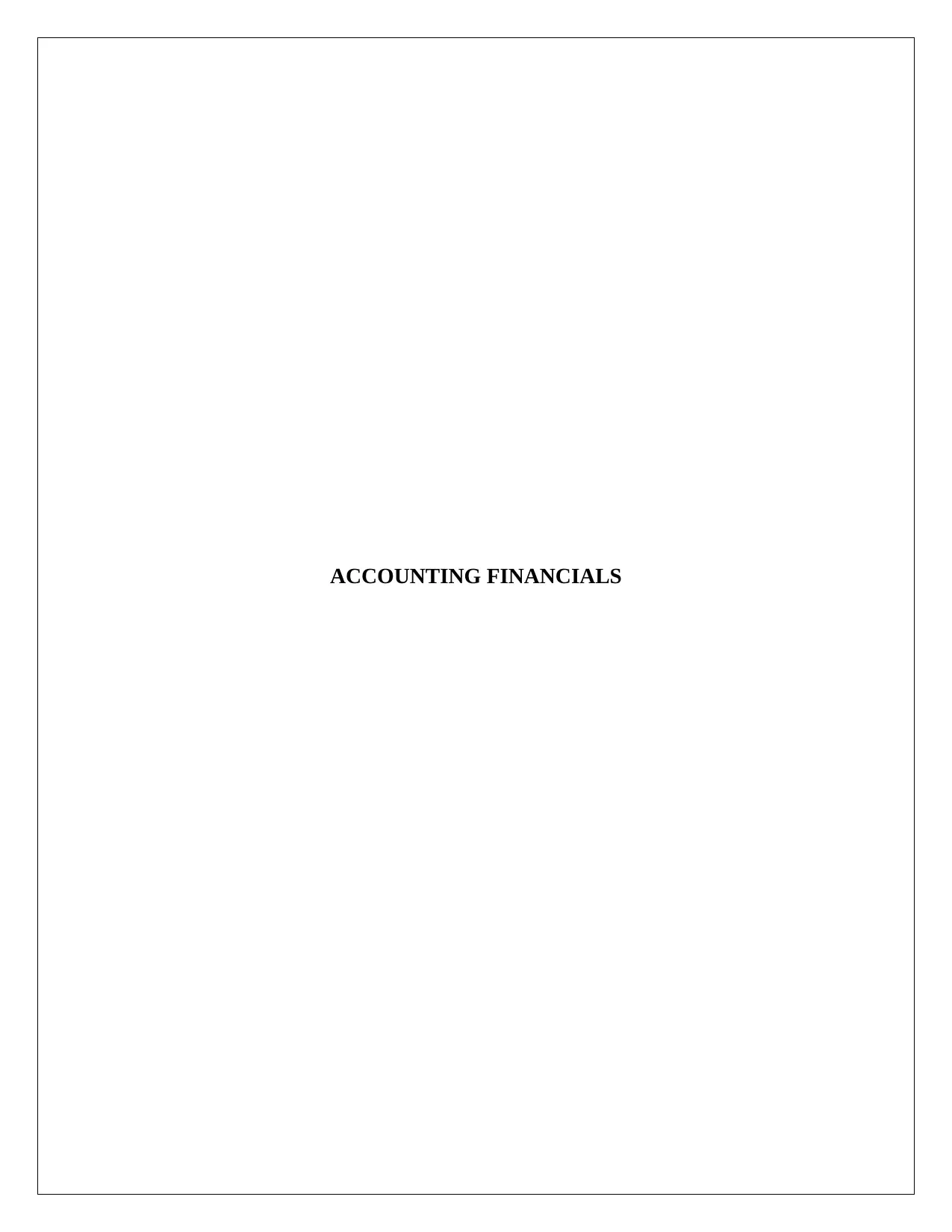
ACCOUNTING FINANCIALS
Paraphrase This Document
Need a fresh take? Get an instant paraphrase of this document with our AI Paraphraser
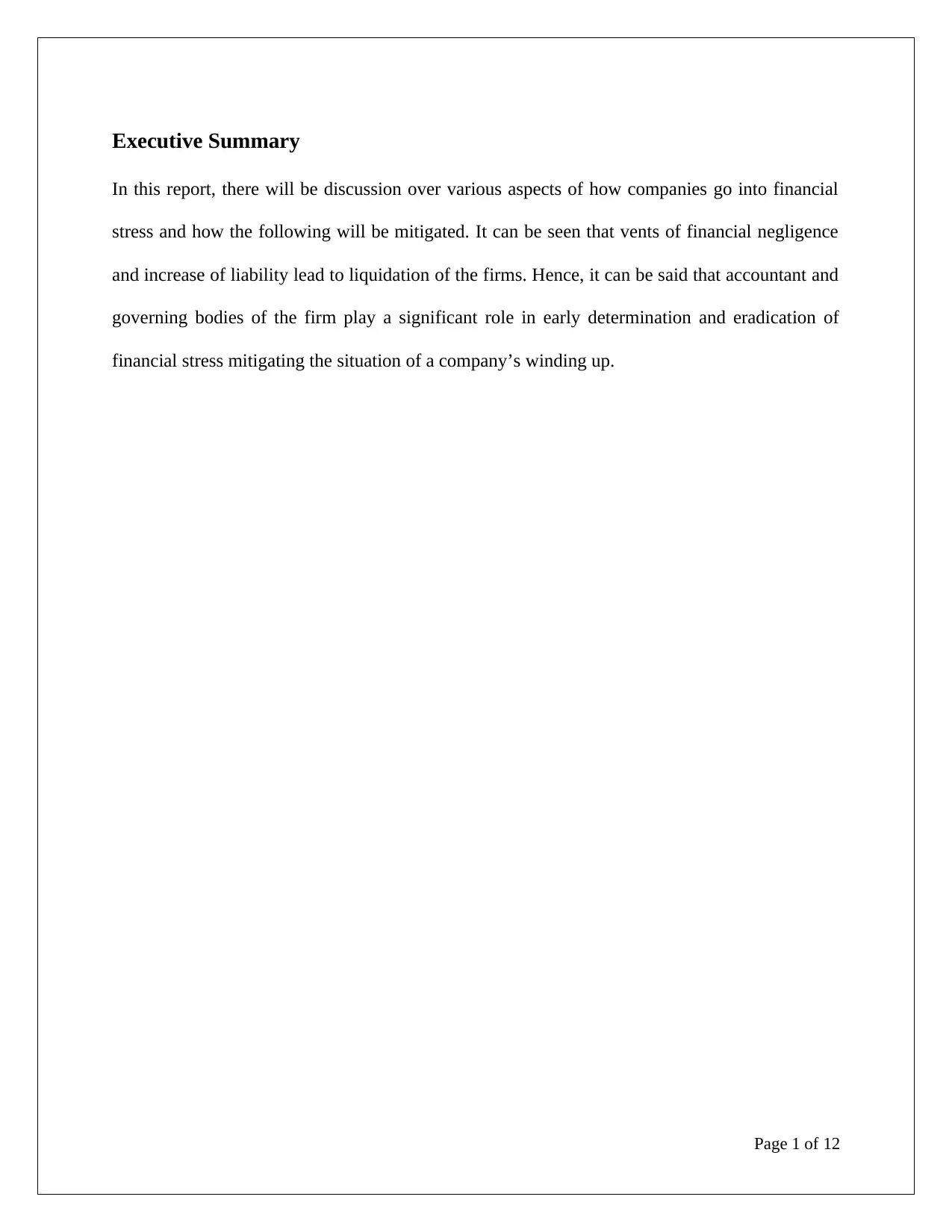
Executive Summary
In this report, there will be discussion over various aspects of how companies go into financial
stress and how the following will be mitigated. It can be seen that vents of financial negligence
and increase of liability lead to liquidation of the firms. Hence, it can be said that accountant and
governing bodies of the firm play a significant role in early determination and eradication of
financial stress mitigating the situation of a company’s winding up.
Page 1 of 12
In this report, there will be discussion over various aspects of how companies go into financial
stress and how the following will be mitigated. It can be seen that vents of financial negligence
and increase of liability lead to liquidation of the firms. Hence, it can be said that accountant and
governing bodies of the firm play a significant role in early determination and eradication of
financial stress mitigating the situation of a company’s winding up.
Page 1 of 12
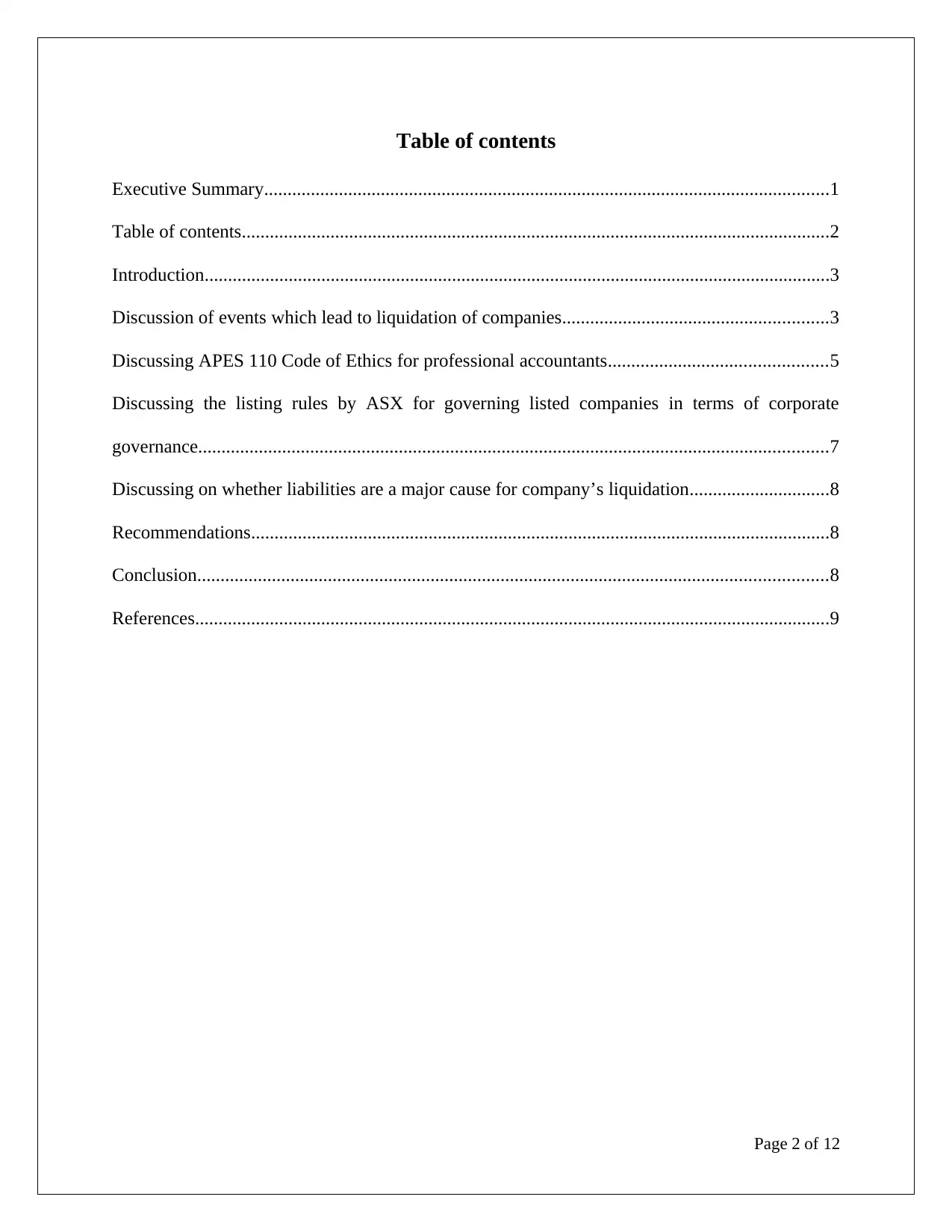
Table of contents
Executive Summary.........................................................................................................................1
Table of contents..............................................................................................................................2
Introduction......................................................................................................................................3
Discussion of events which lead to liquidation of companies.........................................................3
Discussing APES 110 Code of Ethics for professional accountants...............................................5
Discussing the listing rules by ASX for governing listed companies in terms of corporate
governance.......................................................................................................................................7
Discussing on whether liabilities are a major cause for company’s liquidation..............................8
Recommendations............................................................................................................................8
Conclusion.......................................................................................................................................8
References........................................................................................................................................9
Page 2 of 12
Executive Summary.........................................................................................................................1
Table of contents..............................................................................................................................2
Introduction......................................................................................................................................3
Discussion of events which lead to liquidation of companies.........................................................3
Discussing APES 110 Code of Ethics for professional accountants...............................................5
Discussing the listing rules by ASX for governing listed companies in terms of corporate
governance.......................................................................................................................................7
Discussing on whether liabilities are a major cause for company’s liquidation..............................8
Recommendations............................................................................................................................8
Conclusion.......................................................................................................................................8
References........................................................................................................................................9
Page 2 of 12
⊘ This is a preview!⊘
Do you want full access?
Subscribe today to unlock all pages.

Trusted by 1+ million students worldwide
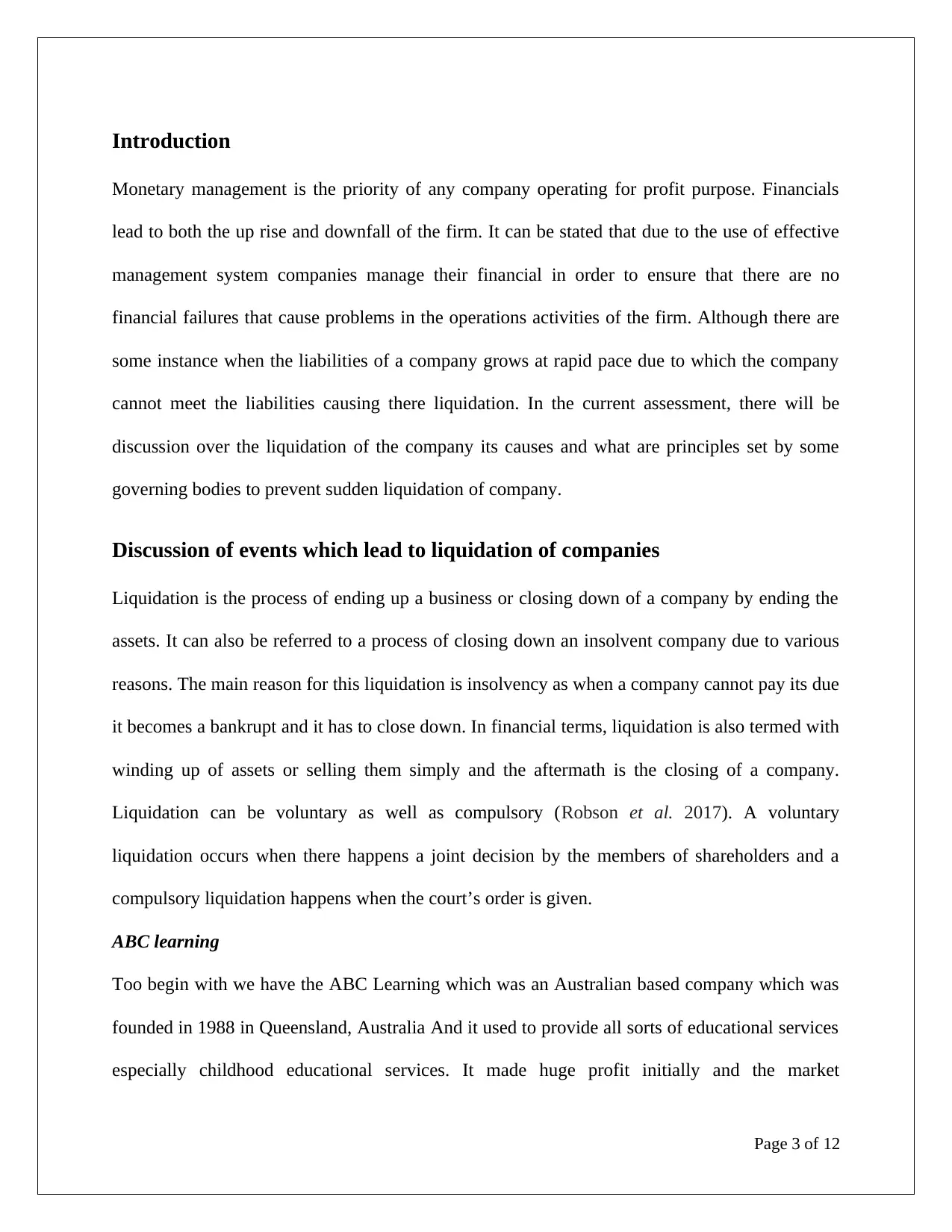
Introduction
Monetary management is the priority of any company operating for profit purpose. Financials
lead to both the up rise and downfall of the firm. It can be stated that due to the use of effective
management system companies manage their financial in order to ensure that there are no
financial failures that cause problems in the operations activities of the firm. Although there are
some instance when the liabilities of a company grows at rapid pace due to which the company
cannot meet the liabilities causing there liquidation. In the current assessment, there will be
discussion over the liquidation of the company its causes and what are principles set by some
governing bodies to prevent sudden liquidation of company.
Discussion of events which lead to liquidation of companies
Liquidation is the process of ending up a business or closing down of a company by ending the
assets. It can also be referred to a process of closing down an insolvent company due to various
reasons. The main reason for this liquidation is insolvency as when a company cannot pay its due
it becomes a bankrupt and it has to close down. In financial terms, liquidation is also termed with
winding up of assets or selling them simply and the aftermath is the closing of a company.
Liquidation can be voluntary as well as compulsory (Robson et al. 2017). A voluntary
liquidation occurs when there happens a joint decision by the members of shareholders and a
compulsory liquidation happens when the court’s order is given.
ABC learning
Too begin with we have the ABC Learning which was an Australian based company which was
founded in 1988 in Queensland, Australia And it used to provide all sorts of educational services
especially childhood educational services. It made huge profit initially and the market
Page 3 of 12
Monetary management is the priority of any company operating for profit purpose. Financials
lead to both the up rise and downfall of the firm. It can be stated that due to the use of effective
management system companies manage their financial in order to ensure that there are no
financial failures that cause problems in the operations activities of the firm. Although there are
some instance when the liabilities of a company grows at rapid pace due to which the company
cannot meet the liabilities causing there liquidation. In the current assessment, there will be
discussion over the liquidation of the company its causes and what are principles set by some
governing bodies to prevent sudden liquidation of company.
Discussion of events which lead to liquidation of companies
Liquidation is the process of ending up a business or closing down of a company by ending the
assets. It can also be referred to a process of closing down an insolvent company due to various
reasons. The main reason for this liquidation is insolvency as when a company cannot pay its due
it becomes a bankrupt and it has to close down. In financial terms, liquidation is also termed with
winding up of assets or selling them simply and the aftermath is the closing of a company.
Liquidation can be voluntary as well as compulsory (Robson et al. 2017). A voluntary
liquidation occurs when there happens a joint decision by the members of shareholders and a
compulsory liquidation happens when the court’s order is given.
ABC learning
Too begin with we have the ABC Learning which was an Australian based company which was
founded in 1988 in Queensland, Australia And it used to provide all sorts of educational services
especially childhood educational services. It made huge profit initially and the market
Page 3 of 12
Paraphrase This Document
Need a fresh take? Get an instant paraphrase of this document with our AI Paraphraser
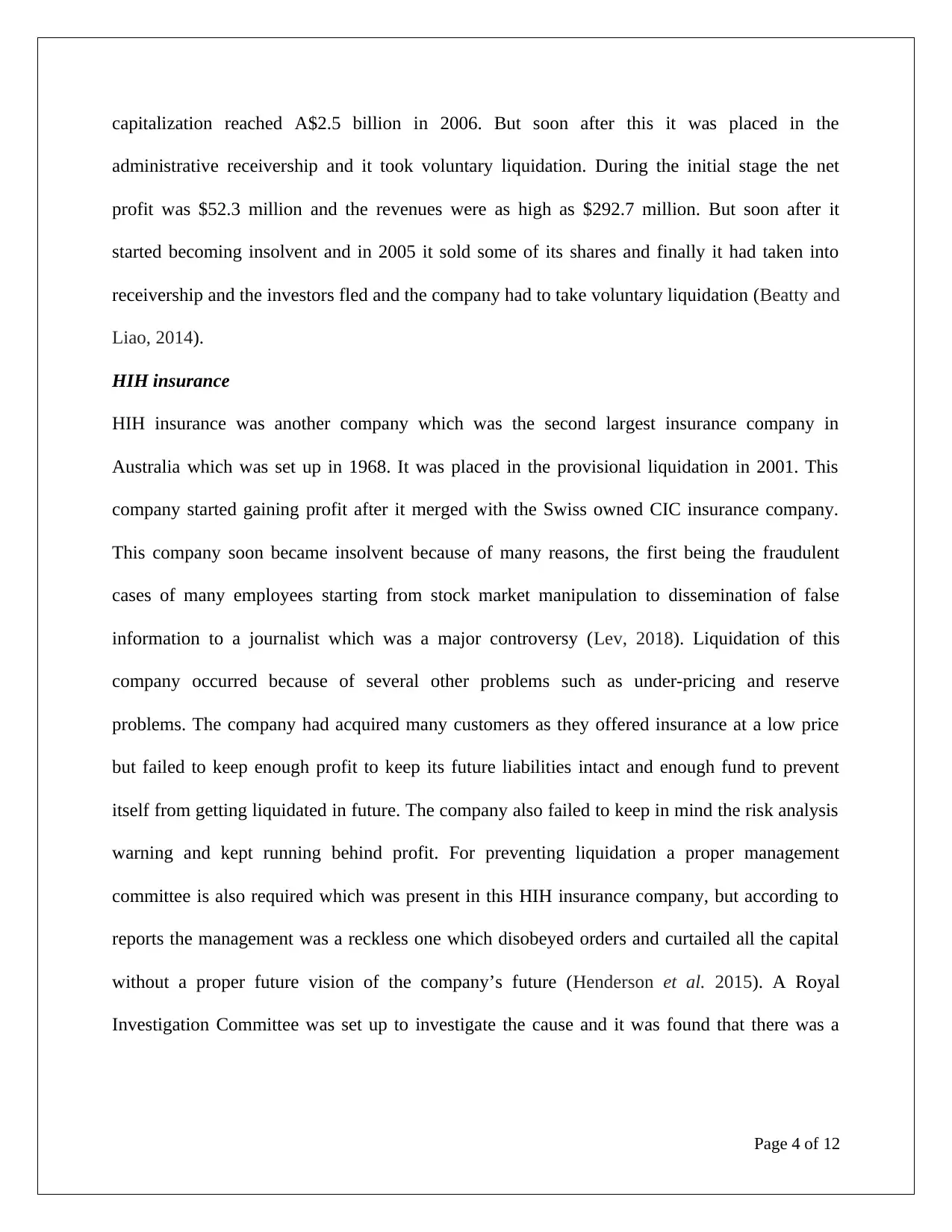
capitalization reached A$2.5 billion in 2006. But soon after this it was placed in the
administrative receivership and it took voluntary liquidation. During the initial stage the net
profit was $52.3 million and the revenues were as high as $292.7 million. But soon after it
started becoming insolvent and in 2005 it sold some of its shares and finally it had taken into
receivership and the investors fled and the company had to take voluntary liquidation (Beatty and
Liao, 2014).
HIH insurance
HIH insurance was another company which was the second largest insurance company in
Australia which was set up in 1968. It was placed in the provisional liquidation in 2001. This
company started gaining profit after it merged with the Swiss owned CIC insurance company.
This company soon became insolvent because of many reasons, the first being the fraudulent
cases of many employees starting from stock market manipulation to dissemination of false
information to a journalist which was a major controversy (Lev, 2018). Liquidation of this
company occurred because of several other problems such as under-pricing and reserve
problems. The company had acquired many customers as they offered insurance at a low price
but failed to keep enough profit to keep its future liabilities intact and enough fund to prevent
itself from getting liquidated in future. The company also failed to keep in mind the risk analysis
warning and kept running behind profit. For preventing liquidation a proper management
committee is also required which was present in this HIH insurance company, but according to
reports the management was a reckless one which disobeyed orders and curtailed all the capital
without a proper future vision of the company’s future (Henderson et al. 2015). A Royal
Investigation Committee was set up to investigate the cause and it was found that there was a
Page 4 of 12
administrative receivership and it took voluntary liquidation. During the initial stage the net
profit was $52.3 million and the revenues were as high as $292.7 million. But soon after it
started becoming insolvent and in 2005 it sold some of its shares and finally it had taken into
receivership and the investors fled and the company had to take voluntary liquidation (Beatty and
Liao, 2014).
HIH insurance
HIH insurance was another company which was the second largest insurance company in
Australia which was set up in 1968. It was placed in the provisional liquidation in 2001. This
company started gaining profit after it merged with the Swiss owned CIC insurance company.
This company soon became insolvent because of many reasons, the first being the fraudulent
cases of many employees starting from stock market manipulation to dissemination of false
information to a journalist which was a major controversy (Lev, 2018). Liquidation of this
company occurred because of several other problems such as under-pricing and reserve
problems. The company had acquired many customers as they offered insurance at a low price
but failed to keep enough profit to keep its future liabilities intact and enough fund to prevent
itself from getting liquidated in future. The company also failed to keep in mind the risk analysis
warning and kept running behind profit. For preventing liquidation a proper management
committee is also required which was present in this HIH insurance company, but according to
reports the management was a reckless one which disobeyed orders and curtailed all the capital
without a proper future vision of the company’s future (Henderson et al. 2015). A Royal
Investigation Committee was set up to investigate the cause and it was found that there was a
Page 4 of 12
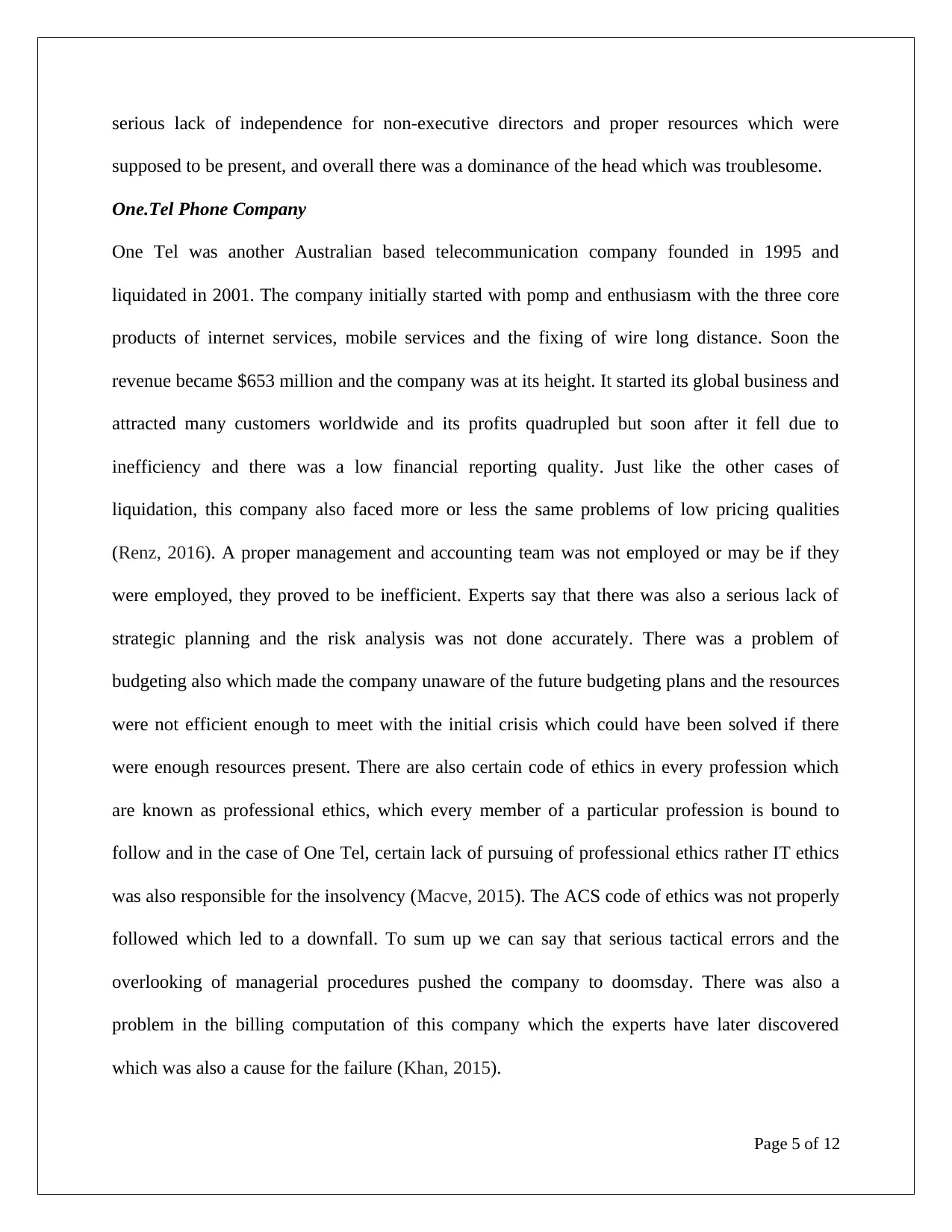
serious lack of independence for non-executive directors and proper resources which were
supposed to be present, and overall there was a dominance of the head which was troublesome.
One.Tel Phone Company
One Tel was another Australian based telecommunication company founded in 1995 and
liquidated in 2001. The company initially started with pomp and enthusiasm with the three core
products of internet services, mobile services and the fixing of wire long distance. Soon the
revenue became $653 million and the company was at its height. It started its global business and
attracted many customers worldwide and its profits quadrupled but soon after it fell due to
inefficiency and there was a low financial reporting quality. Just like the other cases of
liquidation, this company also faced more or less the same problems of low pricing qualities
(Renz, 2016). A proper management and accounting team was not employed or may be if they
were employed, they proved to be inefficient. Experts say that there was also a serious lack of
strategic planning and the risk analysis was not done accurately. There was a problem of
budgeting also which made the company unaware of the future budgeting plans and the resources
were not efficient enough to meet with the initial crisis which could have been solved if there
were enough resources present. There are also certain code of ethics in every profession which
are known as professional ethics, which every member of a particular profession is bound to
follow and in the case of One Tel, certain lack of pursuing of professional ethics rather IT ethics
was also responsible for the insolvency (Macve, 2015). The ACS code of ethics was not properly
followed which led to a downfall. To sum up we can say that serious tactical errors and the
overlooking of managerial procedures pushed the company to doomsday. There was also a
problem in the billing computation of this company which the experts have later discovered
which was also a cause for the failure (Khan, 2015).
Page 5 of 12
supposed to be present, and overall there was a dominance of the head which was troublesome.
One.Tel Phone Company
One Tel was another Australian based telecommunication company founded in 1995 and
liquidated in 2001. The company initially started with pomp and enthusiasm with the three core
products of internet services, mobile services and the fixing of wire long distance. Soon the
revenue became $653 million and the company was at its height. It started its global business and
attracted many customers worldwide and its profits quadrupled but soon after it fell due to
inefficiency and there was a low financial reporting quality. Just like the other cases of
liquidation, this company also faced more or less the same problems of low pricing qualities
(Renz, 2016). A proper management and accounting team was not employed or may be if they
were employed, they proved to be inefficient. Experts say that there was also a serious lack of
strategic planning and the risk analysis was not done accurately. There was a problem of
budgeting also which made the company unaware of the future budgeting plans and the resources
were not efficient enough to meet with the initial crisis which could have been solved if there
were enough resources present. There are also certain code of ethics in every profession which
are known as professional ethics, which every member of a particular profession is bound to
follow and in the case of One Tel, certain lack of pursuing of professional ethics rather IT ethics
was also responsible for the insolvency (Macve, 2015). The ACS code of ethics was not properly
followed which led to a downfall. To sum up we can say that serious tactical errors and the
overlooking of managerial procedures pushed the company to doomsday. There was also a
problem in the billing computation of this company which the experts have later discovered
which was also a cause for the failure (Khan, 2015).
Page 5 of 12
⊘ This is a preview!⊘
Do you want full access?
Subscribe today to unlock all pages.

Trusted by 1+ million students worldwide
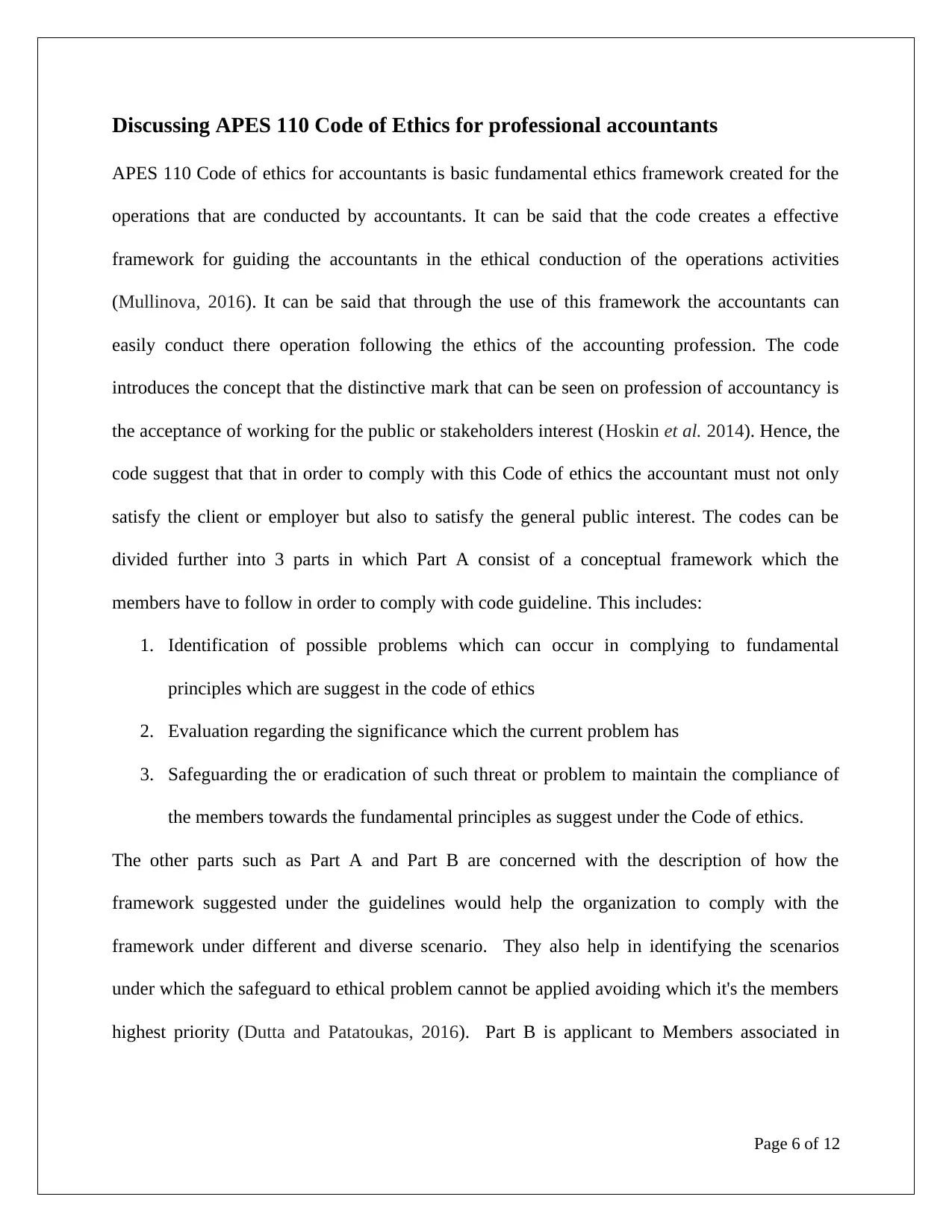
Discussing APES 110 Code of Ethics for professional accountants
APES 110 Code of ethics for accountants is basic fundamental ethics framework created for the
operations that are conducted by accountants. It can be said that the code creates a effective
framework for guiding the accountants in the ethical conduction of the operations activities
(Mullinova, 2016). It can be said that through the use of this framework the accountants can
easily conduct there operation following the ethics of the accounting profession. The code
introduces the concept that the distinctive mark that can be seen on profession of accountancy is
the acceptance of working for the public or stakeholders interest (Hoskin et al. 2014). Hence, the
code suggest that that in order to comply with this Code of ethics the accountant must not only
satisfy the client or employer but also to satisfy the general public interest. The codes can be
divided further into 3 parts in which Part A consist of a conceptual framework which the
members have to follow in order to comply with code guideline. This includes:
1. Identification of possible problems which can occur in complying to fundamental
principles which are suggest in the code of ethics
2. Evaluation regarding the significance which the current problem has
3. Safeguarding the or eradication of such threat or problem to maintain the compliance of
the members towards the fundamental principles as suggest under the Code of ethics.
The other parts such as Part A and Part B are concerned with the description of how the
framework suggested under the guidelines would help the organization to comply with the
framework under different and diverse scenario. They also help in identifying the scenarios
under which the safeguard to ethical problem cannot be applied avoiding which it's the members
highest priority (Dutta and Patatoukas, 2016). Part B is applicant to Members associated in
Page 6 of 12
APES 110 Code of ethics for accountants is basic fundamental ethics framework created for the
operations that are conducted by accountants. It can be said that the code creates a effective
framework for guiding the accountants in the ethical conduction of the operations activities
(Mullinova, 2016). It can be said that through the use of this framework the accountants can
easily conduct there operation following the ethics of the accounting profession. The code
introduces the concept that the distinctive mark that can be seen on profession of accountancy is
the acceptance of working for the public or stakeholders interest (Hoskin et al. 2014). Hence, the
code suggest that that in order to comply with this Code of ethics the accountant must not only
satisfy the client or employer but also to satisfy the general public interest. The codes can be
divided further into 3 parts in which Part A consist of a conceptual framework which the
members have to follow in order to comply with code guideline. This includes:
1. Identification of possible problems which can occur in complying to fundamental
principles which are suggest in the code of ethics
2. Evaluation regarding the significance which the current problem has
3. Safeguarding the or eradication of such threat or problem to maintain the compliance of
the members towards the fundamental principles as suggest under the Code of ethics.
The other parts such as Part A and Part B are concerned with the description of how the
framework suggested under the guidelines would help the organization to comply with the
framework under different and diverse scenario. They also help in identifying the scenarios
under which the safeguard to ethical problem cannot be applied avoiding which it's the members
highest priority (Dutta and Patatoukas, 2016). Part B is applicant to Members associated in
Page 6 of 12
Paraphrase This Document
Need a fresh take? Get an instant paraphrase of this document with our AI Paraphraser
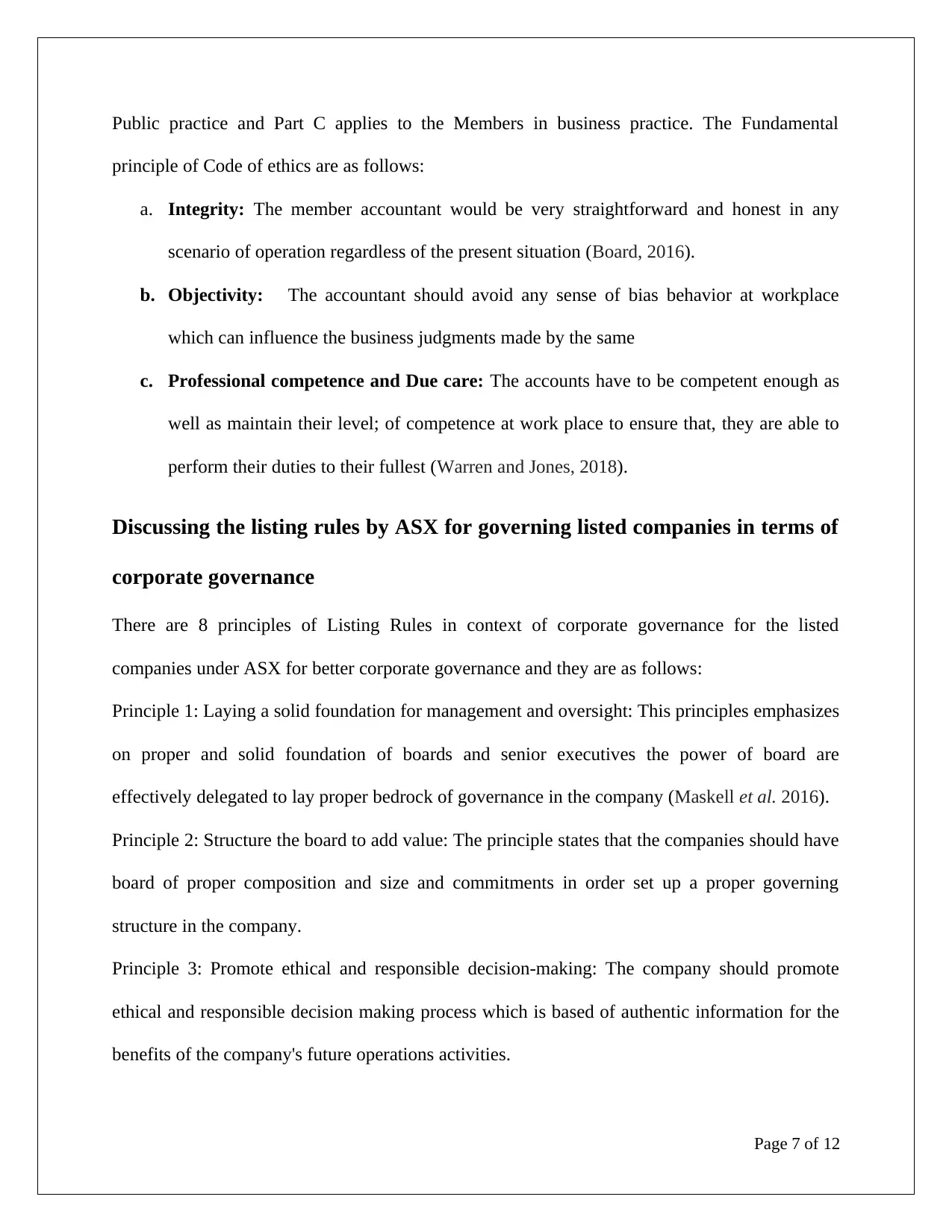
Public practice and Part C applies to the Members in business practice. The Fundamental
principle of Code of ethics are as follows:
a. Integrity: The member accountant would be very straightforward and honest in any
scenario of operation regardless of the present situation (Board, 2016).
b. Objectivity: The accountant should avoid any sense of bias behavior at workplace
which can influence the business judgments made by the same
c. Professional competence and Due care: The accounts have to be competent enough as
well as maintain their level; of competence at work place to ensure that, they are able to
perform their duties to their fullest (Warren and Jones, 2018).
Discussing the listing rules by ASX for governing listed companies in terms of
corporate governance
There are 8 principles of Listing Rules in context of corporate governance for the listed
companies under ASX for better corporate governance and they are as follows:
Principle 1: Laying a solid foundation for management and oversight: This principles emphasizes
on proper and solid foundation of boards and senior executives the power of board are
effectively delegated to lay proper bedrock of governance in the company (Maskell et al. 2016).
Principle 2: Structure the board to add value: The principle states that the companies should have
board of proper composition and size and commitments in order set up a proper governing
structure in the company.
Principle 3: Promote ethical and responsible decision-making: The company should promote
ethical and responsible decision making process which is based of authentic information for the
benefits of the company's future operations activities.
Page 7 of 12
principle of Code of ethics are as follows:
a. Integrity: The member accountant would be very straightforward and honest in any
scenario of operation regardless of the present situation (Board, 2016).
b. Objectivity: The accountant should avoid any sense of bias behavior at workplace
which can influence the business judgments made by the same
c. Professional competence and Due care: The accounts have to be competent enough as
well as maintain their level; of competence at work place to ensure that, they are able to
perform their duties to their fullest (Warren and Jones, 2018).
Discussing the listing rules by ASX for governing listed companies in terms of
corporate governance
There are 8 principles of Listing Rules in context of corporate governance for the listed
companies under ASX for better corporate governance and they are as follows:
Principle 1: Laying a solid foundation for management and oversight: This principles emphasizes
on proper and solid foundation of boards and senior executives the power of board are
effectively delegated to lay proper bedrock of governance in the company (Maskell et al. 2016).
Principle 2: Structure the board to add value: The principle states that the companies should have
board of proper composition and size and commitments in order set up a proper governing
structure in the company.
Principle 3: Promote ethical and responsible decision-making: The company should promote
ethical and responsible decision making process which is based of authentic information for the
benefits of the company's future operations activities.
Page 7 of 12
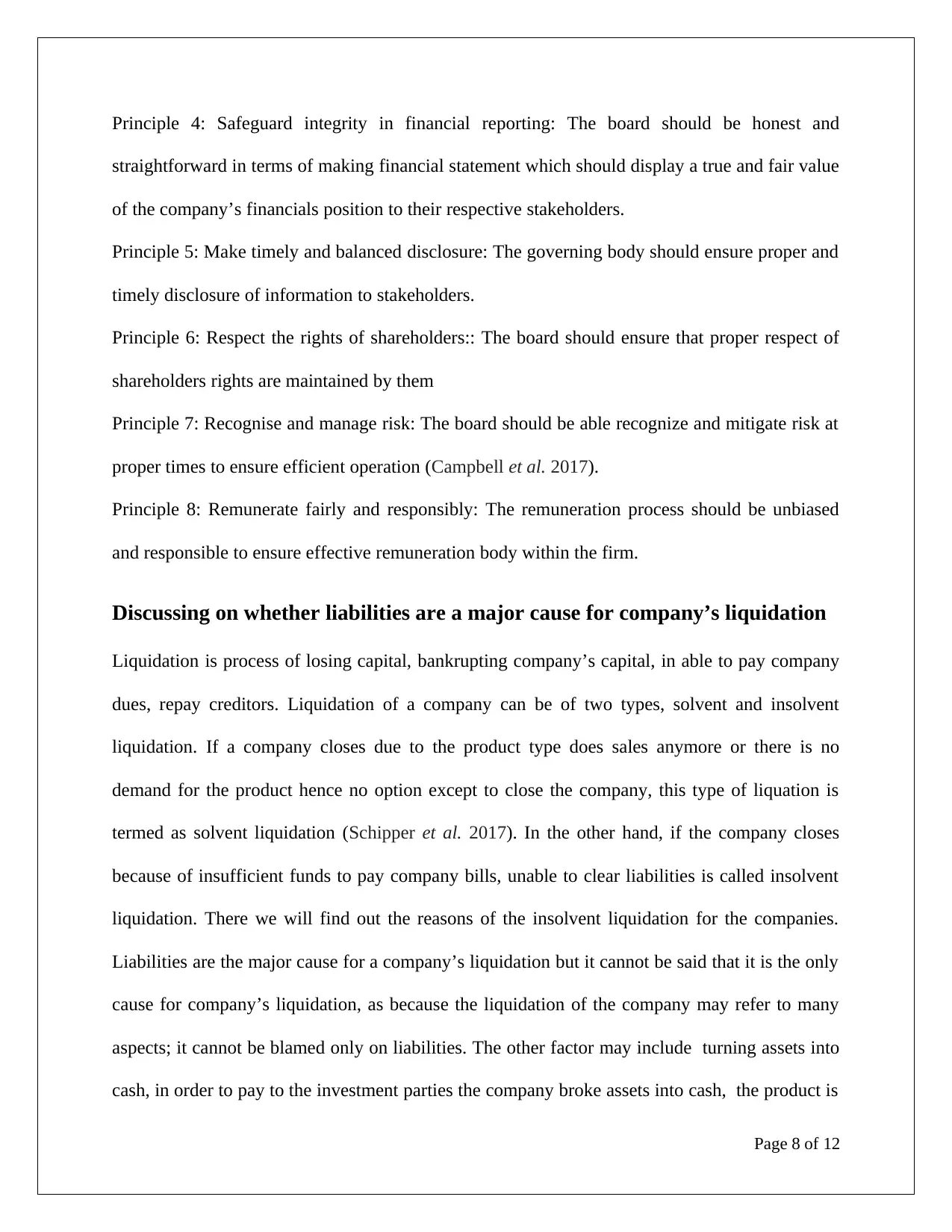
Principle 4: Safeguard integrity in financial reporting: The board should be honest and
straightforward in terms of making financial statement which should display a true and fair value
of the company’s financials position to their respective stakeholders.
Principle 5: Make timely and balanced disclosure: The governing body should ensure proper and
timely disclosure of information to stakeholders.
Principle 6: Respect the rights of shareholders:: The board should ensure that proper respect of
shareholders rights are maintained by them
Principle 7: Recognise and manage risk: The board should be able recognize and mitigate risk at
proper times to ensure efficient operation (Campbell et al. 2017).
Principle 8: Remunerate fairly and responsibly: The remuneration process should be unbiased
and responsible to ensure effective remuneration body within the firm.
Discussing on whether liabilities are a major cause for company’s liquidation
Liquidation is process of losing capital, bankrupting company’s capital, in able to pay company
dues, repay creditors. Liquidation of a company can be of two types, solvent and insolvent
liquidation. If a company closes due to the product type does sales anymore or there is no
demand for the product hence no option except to close the company, this type of liquation is
termed as solvent liquidation (Schipper et al. 2017). In the other hand, if the company closes
because of insufficient funds to pay company bills, unable to clear liabilities is called insolvent
liquidation. There we will find out the reasons of the insolvent liquidation for the companies.
Liabilities are the major cause for a company’s liquidation but it cannot be said that it is the only
cause for company’s liquidation, as because the liquidation of the company may refer to many
aspects; it cannot be blamed only on liabilities. The other factor may include turning assets into
cash, in order to pay to the investment parties the company broke assets into cash, the product is
Page 8 of 12
straightforward in terms of making financial statement which should display a true and fair value
of the company’s financials position to their respective stakeholders.
Principle 5: Make timely and balanced disclosure: The governing body should ensure proper and
timely disclosure of information to stakeholders.
Principle 6: Respect the rights of shareholders:: The board should ensure that proper respect of
shareholders rights are maintained by them
Principle 7: Recognise and manage risk: The board should be able recognize and mitigate risk at
proper times to ensure efficient operation (Campbell et al. 2017).
Principle 8: Remunerate fairly and responsibly: The remuneration process should be unbiased
and responsible to ensure effective remuneration body within the firm.
Discussing on whether liabilities are a major cause for company’s liquidation
Liquidation is process of losing capital, bankrupting company’s capital, in able to pay company
dues, repay creditors. Liquidation of a company can be of two types, solvent and insolvent
liquidation. If a company closes due to the product type does sales anymore or there is no
demand for the product hence no option except to close the company, this type of liquation is
termed as solvent liquidation (Schipper et al. 2017). In the other hand, if the company closes
because of insufficient funds to pay company bills, unable to clear liabilities is called insolvent
liquidation. There we will find out the reasons of the insolvent liquidation for the companies.
Liabilities are the major cause for a company’s liquidation but it cannot be said that it is the only
cause for company’s liquidation, as because the liquidation of the company may refer to many
aspects; it cannot be blamed only on liabilities. The other factor may include turning assets into
cash, in order to pay to the investment parties the company broke assets into cash, the product is
Page 8 of 12
⊘ This is a preview!⊘
Do you want full access?
Subscribe today to unlock all pages.

Trusted by 1+ million students worldwide
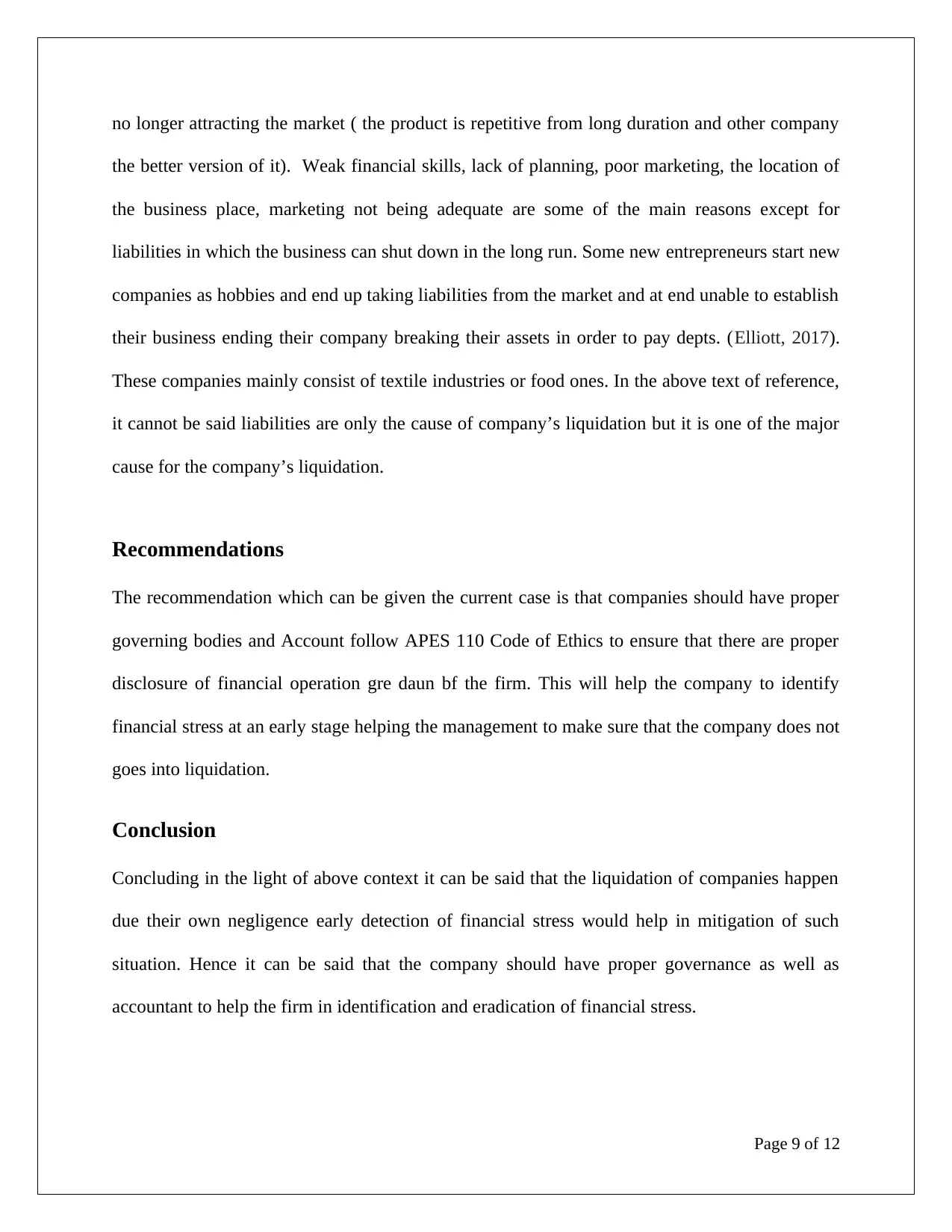
no longer attracting the market ( the product is repetitive from long duration and other company
the better version of it). Weak financial skills, lack of planning, poor marketing, the location of
the business place, marketing not being adequate are some of the main reasons except for
liabilities in which the business can shut down in the long run. Some new entrepreneurs start new
companies as hobbies and end up taking liabilities from the market and at end unable to establish
their business ending their company breaking their assets in order to pay depts. (Elliott, 2017).
These companies mainly consist of textile industries or food ones. In the above text of reference,
it cannot be said liabilities are only the cause of company’s liquidation but it is one of the major
cause for the company’s liquidation.
Recommendations
The recommendation which can be given the current case is that companies should have proper
governing bodies and Account follow APES 110 Code of Ethics to ensure that there are proper
disclosure of financial operation gre daun bf the firm. This will help the company to identify
financial stress at an early stage helping the management to make sure that the company does not
goes into liquidation.
Conclusion
Concluding in the light of above context it can be said that the liquidation of companies happen
due their own negligence early detection of financial stress would help in mitigation of such
situation. Hence it can be said that the company should have proper governance as well as
accountant to help the firm in identification and eradication of financial stress.
Page 9 of 12
the better version of it). Weak financial skills, lack of planning, poor marketing, the location of
the business place, marketing not being adequate are some of the main reasons except for
liabilities in which the business can shut down in the long run. Some new entrepreneurs start new
companies as hobbies and end up taking liabilities from the market and at end unable to establish
their business ending their company breaking their assets in order to pay depts. (Elliott, 2017).
These companies mainly consist of textile industries or food ones. In the above text of reference,
it cannot be said liabilities are only the cause of company’s liquidation but it is one of the major
cause for the company’s liquidation.
Recommendations
The recommendation which can be given the current case is that companies should have proper
governing bodies and Account follow APES 110 Code of Ethics to ensure that there are proper
disclosure of financial operation gre daun bf the firm. This will help the company to identify
financial stress at an early stage helping the management to make sure that the company does not
goes into liquidation.
Conclusion
Concluding in the light of above context it can be said that the liquidation of companies happen
due their own negligence early detection of financial stress would help in mitigation of such
situation. Hence it can be said that the company should have proper governance as well as
accountant to help the firm in identification and eradication of financial stress.
Page 9 of 12
Paraphrase This Document
Need a fresh take? Get an instant paraphrase of this document with our AI Paraphraser
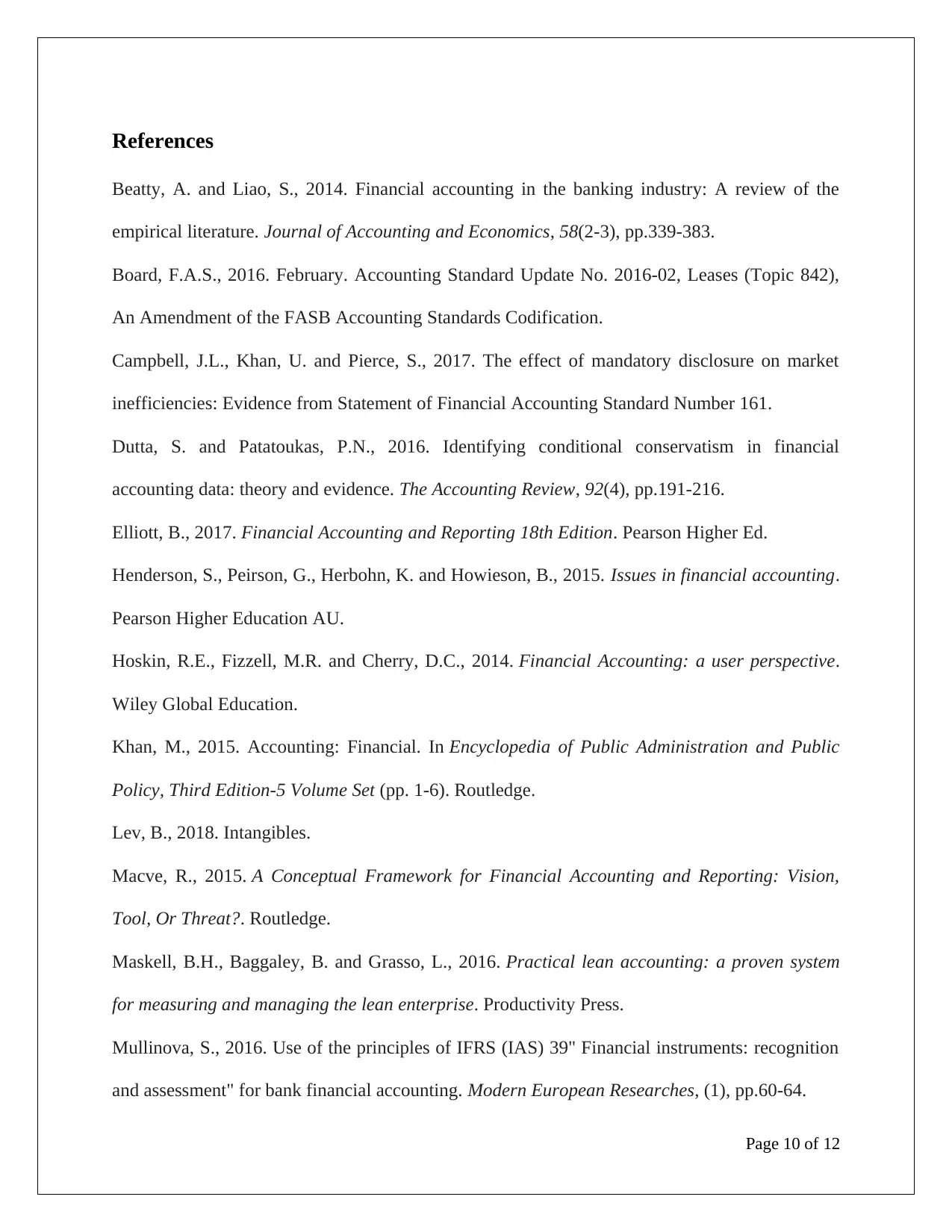
References
Beatty, A. and Liao, S., 2014. Financial accounting in the banking industry: A review of the
empirical literature. Journal of Accounting and Economics, 58(2-3), pp.339-383.
Board, F.A.S., 2016. February. Accounting Standard Update No. 2016-02, Leases (Topic 842),
An Amendment of the FASB Accounting Standards Codification.
Campbell, J.L., Khan, U. and Pierce, S., 2017. The effect of mandatory disclosure on market
inefficiencies: Evidence from Statement of Financial Accounting Standard Number 161.
Dutta, S. and Patatoukas, P.N., 2016. Identifying conditional conservatism in financial
accounting data: theory and evidence. The Accounting Review, 92(4), pp.191-216.
Elliott, B., 2017. Financial Accounting and Reporting 18th Edition. Pearson Higher Ed.
Henderson, S., Peirson, G., Herbohn, K. and Howieson, B., 2015. Issues in financial accounting.
Pearson Higher Education AU.
Hoskin, R.E., Fizzell, M.R. and Cherry, D.C., 2014. Financial Accounting: a user perspective.
Wiley Global Education.
Khan, M., 2015. Accounting: Financial. In Encyclopedia of Public Administration and Public
Policy, Third Edition-5 Volume Set (pp. 1-6). Routledge.
Lev, B., 2018. Intangibles.
Macve, R., 2015. A Conceptual Framework for Financial Accounting and Reporting: Vision,
Tool, Or Threat?. Routledge.
Maskell, B.H., Baggaley, B. and Grasso, L., 2016. Practical lean accounting: a proven system
for measuring and managing the lean enterprise. Productivity Press.
Mullinova, S., 2016. Use of the principles of IFRS (IAS) 39" Financial instruments: recognition
and assessment" for bank financial accounting. Modern European Researches, (1), pp.60-64.
Page 10 of 12
Beatty, A. and Liao, S., 2014. Financial accounting in the banking industry: A review of the
empirical literature. Journal of Accounting and Economics, 58(2-3), pp.339-383.
Board, F.A.S., 2016. February. Accounting Standard Update No. 2016-02, Leases (Topic 842),
An Amendment of the FASB Accounting Standards Codification.
Campbell, J.L., Khan, U. and Pierce, S., 2017. The effect of mandatory disclosure on market
inefficiencies: Evidence from Statement of Financial Accounting Standard Number 161.
Dutta, S. and Patatoukas, P.N., 2016. Identifying conditional conservatism in financial
accounting data: theory and evidence. The Accounting Review, 92(4), pp.191-216.
Elliott, B., 2017. Financial Accounting and Reporting 18th Edition. Pearson Higher Ed.
Henderson, S., Peirson, G., Herbohn, K. and Howieson, B., 2015. Issues in financial accounting.
Pearson Higher Education AU.
Hoskin, R.E., Fizzell, M.R. and Cherry, D.C., 2014. Financial Accounting: a user perspective.
Wiley Global Education.
Khan, M., 2015. Accounting: Financial. In Encyclopedia of Public Administration and Public
Policy, Third Edition-5 Volume Set (pp. 1-6). Routledge.
Lev, B., 2018. Intangibles.
Macve, R., 2015. A Conceptual Framework for Financial Accounting and Reporting: Vision,
Tool, Or Threat?. Routledge.
Maskell, B.H., Baggaley, B. and Grasso, L., 2016. Practical lean accounting: a proven system
for measuring and managing the lean enterprise. Productivity Press.
Mullinova, S., 2016. Use of the principles of IFRS (IAS) 39" Financial instruments: recognition
and assessment" for bank financial accounting. Modern European Researches, (1), pp.60-64.
Page 10 of 12
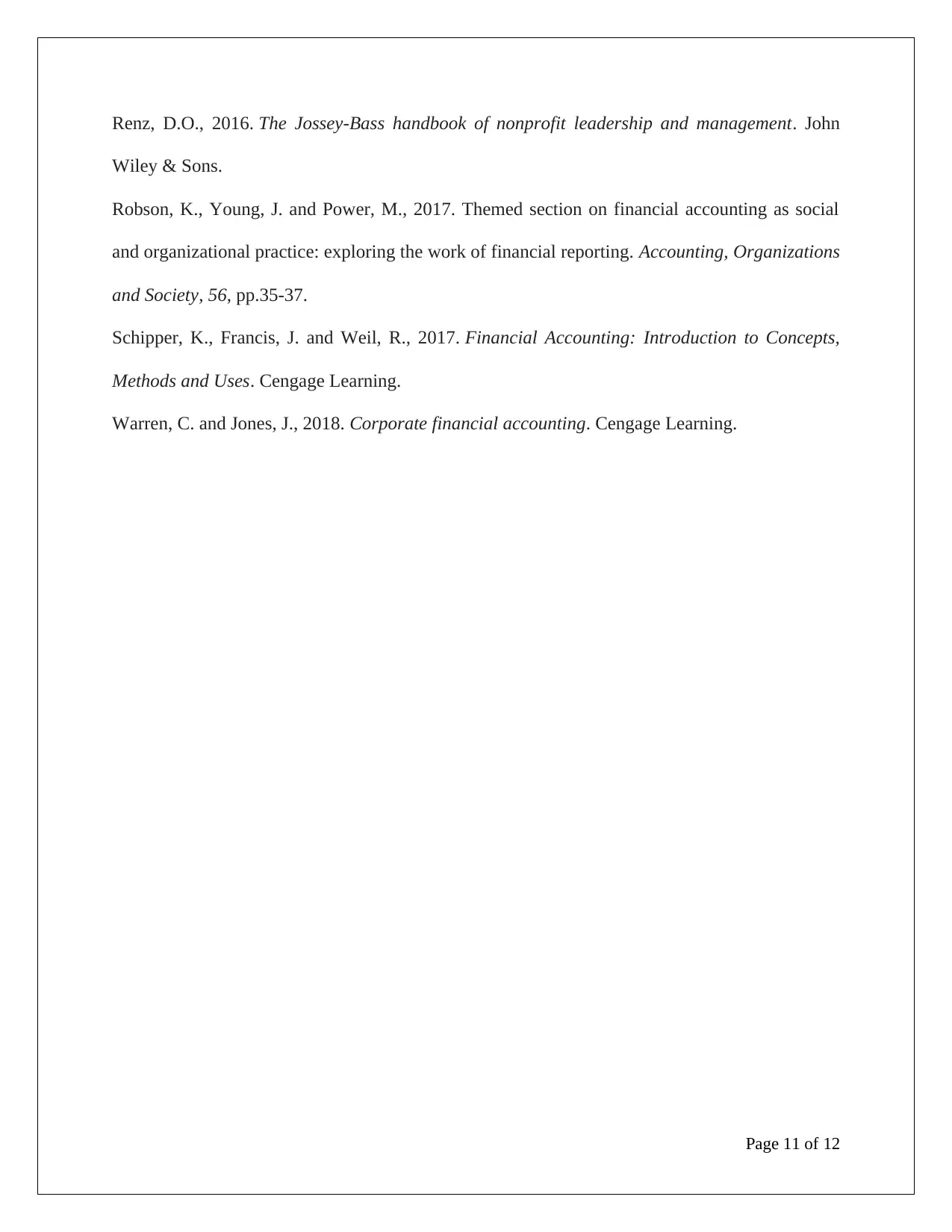
Renz, D.O., 2016. The Jossey-Bass handbook of nonprofit leadership and management. John
Wiley & Sons.
Robson, K., Young, J. and Power, M., 2017. Themed section on financial accounting as social
and organizational practice: exploring the work of financial reporting. Accounting, Organizations
and Society, 56, pp.35-37.
Schipper, K., Francis, J. and Weil, R., 2017. Financial Accounting: Introduction to Concepts,
Methods and Uses. Cengage Learning.
Warren, C. and Jones, J., 2018. Corporate financial accounting. Cengage Learning.
Page 11 of 12
Wiley & Sons.
Robson, K., Young, J. and Power, M., 2017. Themed section on financial accounting as social
and organizational practice: exploring the work of financial reporting. Accounting, Organizations
and Society, 56, pp.35-37.
Schipper, K., Francis, J. and Weil, R., 2017. Financial Accounting: Introduction to Concepts,
Methods and Uses. Cengage Learning.
Warren, C. and Jones, J., 2018. Corporate financial accounting. Cengage Learning.
Page 11 of 12
⊘ This is a preview!⊘
Do you want full access?
Subscribe today to unlock all pages.

Trusted by 1+ million students worldwide
1 out of 12
Related Documents
Your All-in-One AI-Powered Toolkit for Academic Success.
+13062052269
info@desklib.com
Available 24*7 on WhatsApp / Email
![[object Object]](/_next/static/media/star-bottom.7253800d.svg)
Unlock your academic potential
Copyright © 2020–2025 A2Z Services. All Rights Reserved. Developed and managed by ZUCOL.




